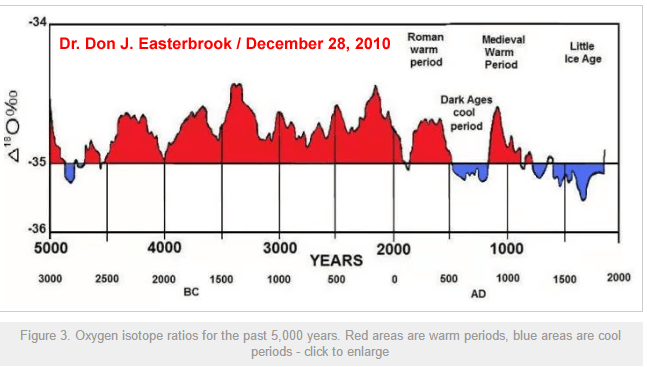Whale Fossils Reveal Past Ice Free Northwest Passage
by Lewis Loflin
Summary: The last 1000 years has been the coldest in the last 10,000 years. A study of whale fossils reveals the arctic has been open 3 times in the last 10,000 years. Click the above for a larger picture.
Note the severe temperature drop ~1600 bring on the Little Ice Age. Even in 2018 global temperatures have not returned to the temperature normal at the time of Alexander the Great.
An exciting study of how climate change since the days of the dinosaurs can be tracked by the remains of past life.
Whale fossils in the Arctic show the opening of the Northwest Passage has occurred on several occasions since the end of the last major ice age around 10,000 BC.
By excavating bowhead whale fossils, research scientist Art Dyke...(is)...starting to understand the history of sea ice in the North. Art describes his work as "reconstructing the environmental conditions of the last 20,000 years."
His efforts focus on the North, specifically on mapping the history of sea ice.
This is a particularly difficult task since sea ice is geologically mute. Although it continually changes shape, expanding and retreating with the seasons, it leaves little to no record of its passage.
Using fossils has proved to be an ingenious way to surmount this challenge...
The most common cause of death for the bowheads studied by Art and his colleagues was entrapment in the ice as it expanded in autumn.
Because the whales followed the ice edge so closely, the location of their fossils indicates the extent to which the ice had previously retreated.
By using radiocarbon dating, Art can determine the age of the fossils.
Since fossils are only found where the ice edge once existed, their age tells Art how far the ice extended at a certain point in history.
Tracking and dating the progress of the bowhead whales entering the Northwest Passage from both the Atlantic and Pacific oceans also lets scientists determine when the passage was open during late summer and fall months.
During an open period, whales from both oceans mixed freely and left their fossils throughout the length of the Passage...
Art and his colleagues have found a significant number of bowhead fossils scattered throughout the length of the Northwest Passage dating from approximately 10,000 years ago.
This abundance of fossils coincides with the warmest part of the Holocene era. (The modern era that began 11,700 years ago.)
At that time, it was approximately three degrees warmer than average temperatures in the mid-twentieth century. (That's what ended the ice age.)
According to Art, the current assumption is that, if the average temperature were to increase by three degrees, the passage would once more be open. Since the mid-1960s, the temperature has risen by one degree.
If this warming trend continues, then by the middle of this century, and for the first time in 3,000 years, the bowhead whales might be able to swim the Northwest Passage again.
Issue 12, March 2007
As of 2019 there is no prospect of an ice-free north.
Ref. http://www.nrcan-rncan.gc.ca/com/elements/issues/12/fossil-eng.php
Update: the above link is no longer good. The new link is http://www.nrcan.gc.ca/earth-sciences/climate-change/landscape-ecosystem/paleo-environmental/3947
To quote the new link:
"A continuous record of marine coastal conditions may be found in the raised beach sequences of Arctic Canada. These beaches have become elevated because of postglacial rebound from removal of the glacial ice load.
Raised beaches were searched for the remains of bowhead whales and for former dwelling of Paleoeskimos.
When dated by radiocarbon dating methods, whale bones can reveal when summer open water (ice-free Northwest Passage) permitted access to regions not accessible historically. Paleoeskimos tended to camp very close to the shoreline.
Therefore, the number and sizes of dwellings on raised beaches are a good indication of former population levels. Dwellings may also be datable by radiocarbon methods using food bones or hearth charcoal.
Numerous sites have been surveyed along the length of the Northwest Passage. The eastern and western approaches have become reliably ice-free in summer under historical climatic conditions, whereas in the central part summer sea ice has been persistent.
The radiocarbon-dated bowhead whale remains indicate that the whales were able to range along the length of the Passage during two intervals (centered on 9000 years ago and 1000 years ago) and that they were able to access the central part from the east about 4000 years ago.
During the first of these intervals (9000 before present) ice cores indicate that summer temperatures were about 3 degrees C warmer than mid 20th Century. Therefore, a warming of 3 degrees C exceeds the opening threshold.
Medieval Warm Period temperatures were probably about 1 degree C warmer than mid-20th Century, which is likely close to threshold conditions for an opening of the passage..."
Updated November 2018 by Lewis Loflin
Web site Copyright Lewis Loflin, All rights reserved.
If using this material on another site, please provide a link back to my site.
- Web Master
- Tri-Cities VA-TN
- General Science
- Hobby Electronics
- US Constitution
- Christianity 101
- Religious Themes
- Fall of the Late Roman Empire
- End of the Vikings in Greenland
- Lost Colony of Roanoke Island
- Whale Fossils Show Ice Free Arctic
- Modern Humans Originate in Asia 80,000 Years Ago
- Hurricanes Versus Climate Change
- Dinosaur Extinction New Questions
- Massive Meteor Explosion Kills Stone Age America
- Mythical Flood or Meteor Strike?
- Useful Science Information on Climate Change Industry
- Climate Change Gravy Train on the Defensive
- Religion is Killing Children
- Science Proves Climate Change
- Posted 9/16/2022
- Why Do EPA Scientists Oppose Public Disclosure?
- Why Public Disclosure is a Right
- 84% of Americans Fear the Government for Good Reason
- Who are the Smartest Countries? Nobel Prizes Tell the Story
- Green Technology Highly Polluting, Environmentally Destructive

